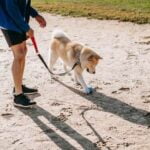Welcoming a new baby into your home is an exciting and joyous occasion, but it can also be a time of adjustment – especially for your furry friend. Training your dog to coexist with a new baby is crucial for creating a safe and harmonious environment for everyone.
A well-trained dog not only brings peace of mind but can also become a protective and loving companion for your little one. In this article, we will delve into the essential steps for effectively training your dog when you have a baby.
Understanding Your Dog’s behavior is key before introducing a new family member. Recognizing signs of stress or anxiety in your dog is vital in ensuring their comfort and safety around the baby. It’s important to establish boundaries for your dog before the baby arrives, whether it’s creating separate spaces or setting specific rules and expectations.
In addition, desensitizing your dog to baby items early on can be highly effective in acclimating them to the changes that come with having an infant at home. Using positive reinforcement training methods, along with supervised interactions between your pooch and the newborn, further reinforces good behavior while promoting a healthy relationship between both parties. Lastly, maintaining consistency and seeking professional help when necessary are also crucial aspects to consider in preparing your furry friend for the upcoming arrival.
Understanding Your Dog’s Behavior
When preparing to introduce a new baby into your home, it is essential to understand your dog’s behavior and how they may react to the changes. Here are some tips for recognizing signs of stress or anxiety in your dog:
- Pay attention to body language: Dogs communicate through their posture, facial expressions, and tail movements. Look for signs of tension, fear, or aggression.
- Monitor vocalizations: Excessive barking, whining, or growling can indicate discomfort or unease in your dog.
- Notice changes in appetite or sleep patterns: A decrease in appetite or disrupted sleep could be a sign that your dog is feeling stressed.
It’s important to remember that every dog is different, so being familiar with your own pet’s typical behavior will help you notice any deviations indicating distress.
Understanding your dog’s behavior before the baby arrives will allow you to address any potential issues early on and take appropriate steps to ensure a smooth transition for both your pet and the new addition to the family. By being proactive and observant, you can create an environment where both your dog and baby can thrive together.
Establishing Boundaries
Preparing your dog for the arrival of a new baby involves establishing clear boundaries. It is essential to set these boundaries before the baby arrives to ensure a smooth transition for both your dog and your family. Boundaries can include physical limits within the home, such as areas where the dog is not allowed to enter, as well as behavioral expectations, such as no jumping on furniture or not begging for food during family meal times.
Creating safe spaces for both the dog and the baby is crucial in establishing boundaries. It is important to designate certain areas of the house where the dog can retreat to and have their own space away from the baby when needed.
Additionally, baby-proofing certain areas of your home will help to ensure that your dog cannot access any potentially hazardous items that may pose a risk to the baby. By setting these boundaries early on, you can help your dog understand their place within the household once the baby arrives.
In addition, consistency is key when it comes to establishing boundaries for your dog. This includes enforcing rules consistently and ensuring that all family members are following the same guidelines. By maintaining consistent boundaries, you can help create a sense of predictability and stability for your dog, which can be beneficial during a time of significant change in the household dynamic.
Desensitizing Your Dog to Baby Items
When preparing your dog for the arrival of a new baby, desensitizing them to baby items is an essential step in the training process. Introducing your dog to baby items in a positive and controlled manner can help them adjust to the changes that come with a new family member. Here are some helpful tips on how to effectively desensitize your dog to baby items.
Gradual Introduction
Start by gradually introducing your dog to baby items such as strollers, cribs, toys, and blankets. Allow your dog to sniff and investigate these items while remaining calm and relaxed. If your dog shows signs of stress or anxiety, provide reassurance and use positive reinforcement techniques to create a positive association with the baby-related objects.
Positive Association
Use treats, praise, and affection to create a positive association between your dog and baby items. For example, give your dog a treat whenever they interact with a baby toy or blanket without showing signs of fear or aggression. This will help them understand that these items are not a threat and can even be associated with something pleasurable.
Consistent Training
Consistency is key when desensitizing your dog to baby items. Make sure to incorporate daily training sessions where you gradually increase the exposure to these objects. It’s important to remain patient and understanding throughout this process as some dogs may take longer to adjust than others.
By following these desensitization techniques, you can help ensure that your dog is comfortable and at ease when the new baby arrives. This proactive approach can contribute to a harmonious relationship between your furry friend and the newest addition to your family.
Positive Reinforcement Training
Using positive reinforcement training methods is an effective way to teach your dog new behaviors and to prepare them for the arrival of a new baby. This approach focuses on rewarding good behavior rather than punishing undesirable actions, which helps create a positive association between the dog and the baby.
Benefits of Positive Reinforcement
Positive reinforcement training has been proven to be more effective in changing behavior compared to punishment-based methods. By rewarding your dog with treats, praise, or playtime when they exhibit desired behaviors around the baby, you can help them understand what is expected of them. This approach also strengthens the bond between the dog and their owner, creating a positive and nurturing environment for both the pet and the new addition to the family.
Important Commands
Teaching your dog specific commands such as “leave it,” “stay,” “go to your bed,” and “come” becomes crucial when a baby is introduced into the household. These commands can help manage interactions between your dog and the baby, prevent unwanted behaviors, and ensure safety for both the dog and the infant. Consistent practice of these commands using positive reinforcement will reinforce good behavior in your dog.
By incorporating positive reinforcement training into your daily routine with your dog, you are not only preparing them for life with a new baby but also fostering a harmonious relationship within your household. It’s essential to be patient, consistent, and persistent in your efforts to train your dog using these methods during this transitional period.
Supervised Interactions
When introducing a new baby to your family, it is crucial to supervise the interactions between your dog and the baby. Dogs can be unpredictable around infants, so it is important to take precautions to ensure their safety. It is recommended to keep your dog on a leash during the initial introduction to the baby. This will allow you to have control over your dog’s movements and behavior, especially if they become overly excited or anxious.
Additionally, it is essential to set boundaries for your dog when it comes to interacting with the baby. For example, teaching them not to jump up on furniture or get too close to the baby’s items can help create a safe environment for both your dog and your newborn. Consistently reinforcing these boundaries through positive reinforcement training will help your dog understand what is expected of them around the baby.
In ongoing interactions between your dog and the baby, it is important to always supervise them closely. This means being attentive to any signs of discomfort or anxiety in your dog, as well as monitoring their behavior around the baby. By maintaining a watchful eye and being mindful of their body language, you can ensure that both your dog and your baby are safe during their interactions.
Consistency and Routine
It’s also crucial to incorporate the baby’s schedule into your dog’s routine. This means gradually introducing changes in feeding times, walk schedules, and playtime so that your dog can become accustomed to the new rhythm of daily life with a baby. For example, if the baby will be taking naps at certain times during the day, it’s beneficial to have your dog accustomed to resting or engaging in quiet activities during those periods.
Another aspect of consistency and routine is ensuring that your dog continues to receive adequate exercise and mental stimulation. Many behavioral issues in dogs stem from boredom or lack of physical activity.
By making sure that your dog’s needs are met in these areas, you can reduce the likelihood of any behavioral problems arising once the baby arrives. Additionally, regular obedience training sessions should be maintained so that your dog remains responsive to commands even with the presence of a baby.
| Aspect | Importance |
|---|---|
| Consistent schedule | Makes dog feel secure |
| Incorporating baby’s schedule | Smooth transition for dog |
| Regular exercise and mental stimulation | Reduces likelihood of behavioral problems |
Seeking Professional Help
When preparing your dog for the arrival of a new baby, it is important to recognize that every dog is unique. While some dogs may adjust easily to the new addition, others may struggle with the changes in routine and attention.
In some cases, seeking professional help from a trainer or behaviorist can be highly beneficial. These experts have the knowledge and experience to assess your dog’s behavior and provide customized training plans to ensure a smooth transition for both your dog and your baby.
Finding a qualified professional to assist with training your dog when you have a baby is crucial. It is recommended to seek out trainers or behaviorists who specialize in positive reinforcement methods, as these techniques are generally more effective and promote a strong bond between you, your dog, and your baby. Additionally, consider looking for professionals who have experience specifically in training dogs in preparation for life with an infant.
It’s important to note that seeking professional help does not mean that you’ve failed as a pet owner. On the contrary, it shows that you are committed to providing the best possible environment for both your dog and your baby. Trainers and behaviorists can offer valuable guidance and support throughout the training process, ultimately setting the stage for a harmonious relationship between your dog and your little one.
Conclusion
In conclusion, preparing your dog for the arrival of a new baby is crucial for creating a safe and harmonious environment for both your pet and your family. Understanding your dog’s behavior and body language, setting clear boundaries, desensitizing them to baby items, and using positive reinforcement training are all essential steps in ensuring a smooth transition.
Additionally, supervised interactions, consistency, and seeking professional help if needed are all important considerations when training your dog for the arrival of a baby.
It’s important to remember that this process takes time and patience. It’s unlikely that your dog’s behavior will change overnight, so persistence is key.
With the right approach and guidance, you can successfully train your dog to coexist with your new family member in a safe and loving manner. By implementing these strategies and being proactive in preparing your dog for the changes ahead, you can create a positive and fulfilling dynamic between your pet and your baby.
Ultimately, the goal is to create a nurturing environment where both your dog and your baby can thrive together. With dedication, consistency, and understanding, it is possible to build a strong bond between your pet and child while maintaining a peaceful household. Remember to be patient with both yourself and your furry friend as you navigate this important stage in their lives.
Frequently Asked Questions
How Do You Help Your Dog When You Have a Baby?
When introducing a new baby to the family, it’s important to gradually acclimate the dog to the sounds, smells, and routines associated with the baby. This can include playing recordings of baby noises, allowing the dog to sniff baby-related items, and establishing new daily routines that involve both the dog and baby.
It’s also crucial to maintain consistent rules and boundaries for the dog to prevent any potential issues.
How Do You Train a Dog With a Baby?
Training a dog with a baby involves teaching them how to interact safely and calmly with the new family member. This can include basic obedience training, such as “sit” and “stay,” as well as desensitization exercises to noises and movements associated with babies.
Positive reinforcement is key when training a dog around a baby, as it helps create positive associations between the two.
How Long Does It Take for a Dog to Adjust to a New Baby?
The amount of time it takes for a dog to adjust to a new baby can vary depending on their personality, previous experiences, and how they are introduced to the baby. Some dogs may adjust quickly within a few weeks, while others may take several months to fully adapt.
Patience, consistency, and positive reinforcement are essential when helping a dog adjust to life with a new baby in the household.

Welcome to the blog! I am a professional dog trainer and have been working with dogs for many years. In this blog, I will be discussing various topics related to dog training, including tips, tricks, and advice. I hope you find this information helpful and informative. Thanks for reading!





